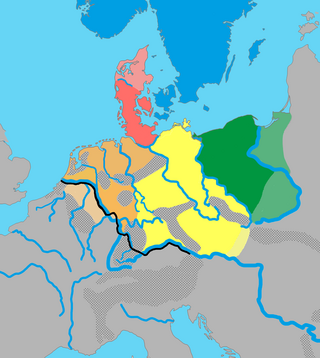Weser–Rhine Germanic
Language group From Wikipedia, the free encyclopedia
Weser–Rhine Germanic is a proposed group of prehistoric West Germanic dialects, which includes both Central German dialects and Low Franconian, the ancestor of Dutch.[1][2] The term was introduced by the German linguist Friedrich Maurer as a replacement for the older term Istvaeonic, with which it is essentially synonymous. The term Rhine–Weser Germanic is sometimes preferred.[3]
| Weser–Rhine Germanic | |
|---|---|
| Rhine–Weser Germanic, Istvaeonic | |
| Geographic distribution | Around the Weser and Rhine rivers |
| Linguistic classification | Indo-European
|
| Subdivisions | |
| Language codes | |
| ISO 639-3 | – |
 The distribution of the primary Germanic languages in Europe c. AD 1:
Weser–Rhine Germanic, or Istvaeonic
| |
Nomenclature
The term Istvaeonic is derived from the Istvæones (or Istvaeones), a culturo-linguistic grouping of Germanic tribes, mentioned by Tacitus in his Germania.[4] Pliny the Elder further specified its meaning by claiming that the Istævones lived near the Rhine.[5] Maurer used Pliny to refer to the dialects spoken by the Franks and Chatti around the northwestern banks of the Rhine, which were presumed to be descendants of the earlier Istvaeones.[6] The Weser is a river in Germany, east of and parallel to the Rhine. The terms Rhine–Weser or Weser–Rhine, therefore, both describe the area between the two rivers as a meaningful cultural-linguistic region.
Theory

Maurer asserted that the cladistic tree model, ubiquitously used in 19th and early 20th century linguistics, was too inaccurate to describe the relation between the modern Germanic languages, especially those belonging to its Western branch. Rather than depicting Old English, Old Dutch, Old Saxon, Old Frisian and Old High German to have simply 'branched off' a single common 'Proto-West Germanic', he proposed that there had been much more distance between the languages and the dialects of the Germanic regions.[7]
Weser–Rhine Germanic seems to have been transitional between Elbe Germanic and North Sea Germanic, with a few innovations of their own.[8]
References
Sources
Further reading
See also
Wikiwand - on
Seamless Wikipedia browsing. On steroids.
